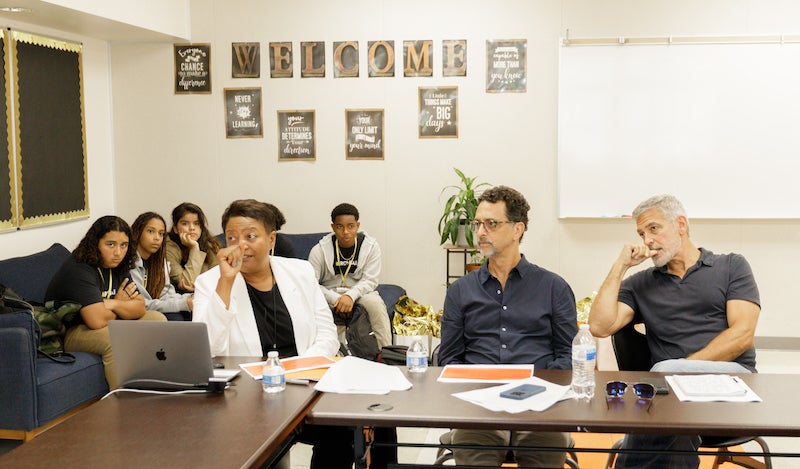
Ignoring the call for diverse workers behind the camera is ”just no longer acceptable,“ says Hollywood trade union official Mike Miller
The celebrities involved have no say in which students are accepted into the program, and as with other magnet programs, any student who qualifies to attend a LAUSD high school may apply. But the district’s diverse student population naturally meets the goals of the entertainment industry’s effort to diversify below the line employment, Principal Blanca Cruz said. According to U.S. News and World Report, enrollment in the city’s 782 public schools 782 is 90% minority and 60% economically disadvantaged.
And, though magnet program students often come from outside the school neighborhood, being downtown will naturally attract interest from students living in the surrounding area. “It had to be a school that was going to be accessible to the community and students that normally don’t get represented (in the entertainment industry),” Cruz told TheWrap.
IATSE has been involved in diversity outreach for years, but the magnet school represents the first time the union has gotten involved at the high school level. “Not everyone can be the next movie star or director, but there are tens and tens of thousands of technicians and artisans that are behind the camera and make really good livings in our industry,” Miller said.
He called the industry’s tendency to blame lack of diversity behind the cameras on complex union contracts a “cop out.” “It’s sometimes it’s easy to look back and say, well, we can’t do this, because that’s not how we’ve always done it,” Miller said. “And that’s just no longer acceptable.”
The school previously had been developing a magnet program focusing on below-the-line jobs in recent years; now the program has funding, a new curriculum and a board of directors that includes Kerry Washington, Eva Longoria, Working Title Co-Chairman Eric Fellner and CAA Co-Chair Bryan Lourd, among many others. Like other LAUSD magnet programs, the magnet is housed in its own building on the Edward R. Roybal Learning Center campus and its students take classes in other buildings as well.
“George Clooney said it best — you can study to be an actor, you can study to be a writer, you can study to be a dancer or to be a composer, but that does not necessarily translate into a job,” said Deborah Marcus, executive director of the CAA Foundation, the agency’s philanthropic arm that is the organizational entity for the Hollywood effort (LAUSD has been a pro bono client of CAA since 2018).
The list of Hollywood supporters appears to be about as long as the special effects credits for “Dune”: Amazon Studios, Disney, Fox Corporation, NBCUniversal/Telemundo Enterprises, Paramount, and Warner Bros. Discovery have signed on as founding partners of the fund.
Fox Entertainment CEO Charlie Collier; NBCUniversal EVP and Chief Diversity Officer Craig Robinson and Marva Smalls, EVP and Global Head of Inclusion at Paramount, have joined the Roybal Advisory Board, which also includes Clooney, Heslov, Lourd, Washington, Nicole Avant, Longoria, Kaling, Don Cheadle, Working Title founders Tim Bevan and Eric Fellner, Jim Gianopulos and Paul Buccieri, president and chairman A+E Networks Group. Some of these heavyweights are donating money, while others are connecting students to experts in below-the-line fields or providing in-kind equipment donations and instruction.
The expert advice is coming from acclaimed Hollywood veterans like costume designers Ruth Carter and Emilio Sosa; production designers Wynn Thomas and Korey Washington; hair and make-up artist Howard Berger; cinematographer Erik Messerschmidt; lighting director Danny Gonzalez; supervising sound editors Bobbi Banks and Glenfield Payne; film editor Michael Tronick; animation artist Vicky Pui; and visual effects producer Brooke Breton, all of whom are slated to serve inaugural members of the Roybal Industry Council.

Entertainment industry support for public schools has been on the radar recently because of the popularity of “Abbott Elementary,” the ABC comedy set in an underserved Philadelphia public school which took a writing Emmy this year for its creator and star, Quinta Brunson. The producers of the show have engaged in numerous marketing givebacks targeting underserved public schools including hosting an awards show style “gifting suite” for L.A. teachers at West Century City in mid-September. However, Cruz said she believes the focus on teachers as frontline workers during the pandemic has done more in recent years to raise the profile of the plight of underserved public schools nationwide.
“During COVID, there has been a heightened awareness of what public school teachers are doing, just like we saw with our nurses and doctors and heroes,” Cruz said. “It’s not just a school, there’s a lot that goes on inside of that building.”
While progress in diversity below the line is perhaps less visible than on the screen, in writers’ rooms or in executive suites, Miller said the effort is equally crucial for the industry.
“You (need) folks behind the camera, who have the experiences of what’s going on in front of the camera,” he said. “The idea that those folks are going to have the cultural and life experiences of the people that they’re working with is incredibly important. You know, the idea that we have folks that can deal with natural hair — we’ve been working diligently with our makeup and hair locals to create training and access for people of color into the industry. Those kinds of things matter a lot. And when you have a diverse workforce, that’s going to be reflected in the product that’s made.”
- timewarnerent.comhttps://timewarnerent.com/author/gleberman1236/
- timewarnerent.comhttps://timewarnerent.com/author/gleberman1236/
- timewarnerent.comhttps://timewarnerent.com/author/gleberman1236/
- timewarnerent.comhttps://timewarnerent.com/author/gleberman1236/
















